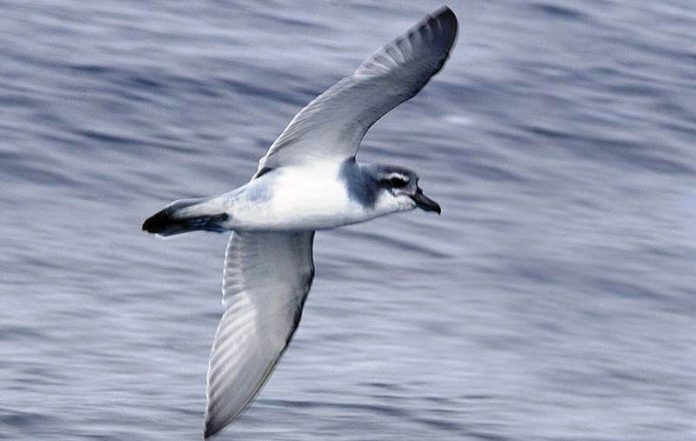The Broad-billed Prion (Pachyptila vittata) is one of the largest and most northward-ranging of the Southern Hemisphere prions. Its broad head, proportioned to hold its massively wide bill, and steep forehead give it a frog-like appearance that distinguishes it from other blue-grey petrels on the wing.
Like all prions, the broad-billed is blue-gray above, white below, with a dark band running across the wings and back that forms the letter M in flight; and the tail is wedge-shaped with a terminal black band. Flight is also typical of prions.
These dashers of the ocean, both dumpy in body and rather short in wing, are fast, erratic fliers when on the move. Often traveling in flocks and avoiding ships, they skim the sea, rising and falling and twisting from side to side. Hence all gleaming white breasts showing one moment, then gray backs lost against the ocean the next.
The heaviest-billed race of the Broad-billed Prion, from the Chatham Islands. Finding concentrations of their food-krill, squid, and plankton at places of mixing and upwelling ocean currents, birds will gather to feed day and night, often associating with whales harvesting the same bonanza: hence their other name, ‘whale-birds’. With its bill edged with comb-like plates for sieving plankton, the Broad-billed Prion has its own particular method of feeding.
It hydroplanes. Holding out its wings for balance, it rests its breast on the surface of the water and kicks its feet to propel it rapidly along. The bill is plunged open into the water and scoops up food and water into an extendable chin pouch around the tongue. When the pouch is full, the bill is closed, and the pouch contracts to squeeze the water out through the bill’s plates, trapping the food.
The birds will also swim and dive adeptly for their prey. Broad-billed prions converge in vast numbers to nest on their southern ocean breeding islands from July to October. Many remain in the vicinity throughout the year, even roosting in their burrows through early winter, perhaps to maintain ownership.
Like other prions, they are burrow-nesters and usually night-active at their colonies. Some of the colonies are enormous, such as those on South East Island in the Chathams, for example, spreading over vast areas of forest floor and numbering many thousands. These great numbers and the occasional daytime visits by adults make the prions easy prey to skuas and gulls, giant petrels, and even rats.
On land, Broad-billed and other prions are nonetheless not as helpless as other petrels, able to take flight directly even on calm days. Although fighting actively among one another to take and hold nest holes, they do not spit stomach oil in defense and will tolerate another pair in the same burrow. Such burrows are compound, with separate chambers or branches for each pair.
Males hold the sites in the one-to-two weeks that females spend at sea prior to laying, in August–November. The young chick hatches within another two months and, tended by both adults, fledges in December and March, after being deserted for the last week or so.
Adults molt under rocks onshore in February-March and then take to the sea in the vicinity of their islands. Fledgling immature disperse further north, and it is these that are occasionally wrecked on southern Australian and New Zealand beaches by winter storms. The narrowest-billed race of the Broad-billed Prion still has a wide bill.
It is also known as Broad-billed Dove Petrel, Medium-billed Prian, Lesser Broad-billed Prian, or Whale-bird. The size of a broad-billed prion is about 282–302 mm. Both adult sexes are similar. Upperparts from head to wings and tail pale leaden; darker line through eye and conspicuous whitish eyebrow and lores.
Also, the tail tip and line along the shoulders of the wing and mantle are narrowly dusky. Underparts from chin to crissum are pure white. The eyes are brown with a bill leaden, very broad and bowed, with a small hook, and conspicuous yellow lamellae (plates) along the maxilla; chin pouch mauve. Feet and webs are leaden blues.
The immature birds have narrower bills, whereas the downy young are smokey gray, whiter below, and almost bare-faced, becoming bluer above and whiter below. Broad-billed Prion courtship, a crooning, rather rasping call with rhythmical alternating stress on the second and fourth syllables: ku-a, ku-a, kuk. This phrase is repeated rapidly with variations several times in succession. Chicks cheep and squawk harshly in alarm.
The nesting and breeding season is July-March, over summer, in large colonies. Nest a burrow over one meter long, with a leaf-lined egg chamber at the end, in soft soil in a variety of sites undercover of cushion plants and shrubbery.
The bird lays one white; oval-shaped egg about 50 x 36 mm. The normal incubation period lasts about 55–56 days, for both sexes. Therefore, the young bird fledges in about 46–49 days.
The distribution of Broad-billed Prion is subantarctic and temperate oceans of the Southern Hemisphere, ranging north to southern Australian coasts and even tropics of the Indian Ocean in winter.
There are three races, all reaching Australia: enlarge, with the very broad steel-grey bill, breeding in southern New Zealand and adjacent islands, and Tristan da Cunha group. Also, another medium, with the slightly narrower steel-grey bill, breeds on St. Paul and formerly Amsterdam islands; a third smaller, with the narrower bluish bill, breeds in the Crozets, Prince Edward, and Marian Islands.









